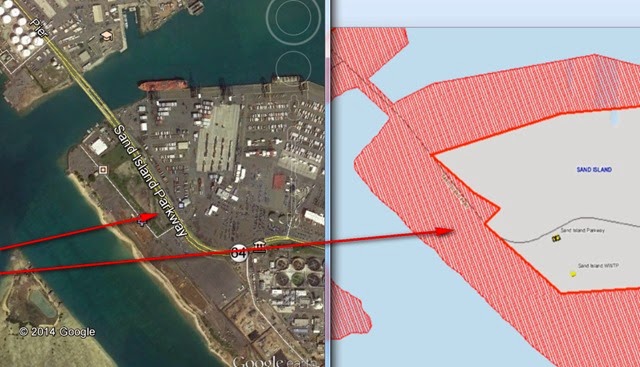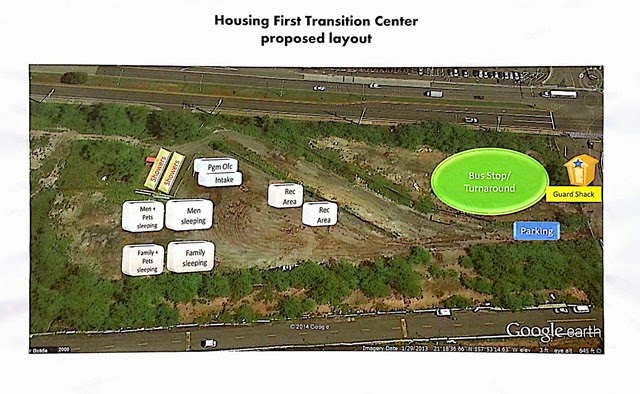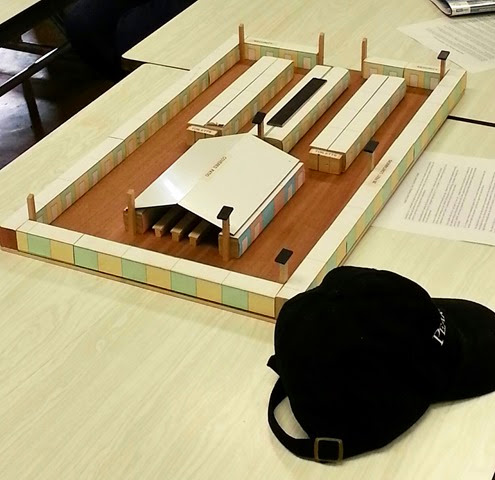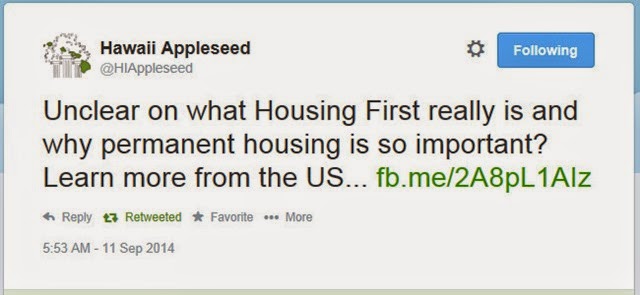Tuesday, September 30, 2014
Judge Nakasone rules that courts cannot decide question of Calvin Say’s residency
“
IT IS HEREBY ORDERED, ADJUDGED, AND DECREED that Respondent Say and Intervenor House of Representatives' Motions to Dismiss are granted, and the Petition for Quo Warranto filed December 31, 2012, is dismissed without prejudice to the claims therein being brought in the proper forum, which is the House of Representatives of the State of Hawaii.—Judge Karen Nakasone
”
by Larry Geller
Judge Karen Nakasone’s decision, released today, did not decide whether former speaker Calvin Say lives in his district or not. The judge ruled that Hawaii courts do not have jurisdiction, so the matter would have to be handled by the House of Representatives.
Here is the full text—it is an OCR copy and may contain errors. Do not rely on this copy.
(Note: Quo Warranto: A legal proceeding during which an individual's right to hold an office or governmental privilege is challenged.)
Download Hussey et. al. v. Say from Disappeared News
Judge Karen Nakasone expected to issue ruling on Calvin Say residency motions today
by Larry Geller
At the close of a hearing on two motions to dismiss the latest challenge to former speaker Calvin Say’s residence held on September 18, Judge Karen Nakasone announced that she would take the matter under advisement and rule no later than September 30.
Today is September 30.
Six Palolo residents argued that Say lives with his wife in Pauao Valley, which is in a different district, and that his house in the Palolo valley is empty.
If Judge Nakasone rules favorably on either motion to dismiss, that will end the challenge to Say’s qualification to serve, at least for the moment.
Calvin Say may be home nervously sipping his tea or coffee and wondering if his political future is saved.
The question may be, which home?
Monday, September 29, 2014
Honolulu police chief likely to be grilled at legislative hearing Sept 30–you can be there
by Larry Geller
Police Chief Louis Kealoha will have to do some good talking tomorrow at a public hearing called jointly by the House and Senate public safety commissions. At this writing, the police officer caught on video in an apparent domestic violence incident has not yet been arrested, and there has been no action announced against the five officers who failed to file the required police report.
If you get there early, you can witness Police Chief Kealoha perhaps squirming on the hot seat at the legislative hearing. But plan on getting there very early, the room will hold only so many. Often a hallway TV monitor is provided for those who could not squeeze in, but I don’t know if that is planned for tomorrow. If you can’t come, check `Olelo, maybe channel 55, at 10 a.m. The squirmiest parts will most certainly be on commercial TV tomorrow night.
Although the root cause for public outrage is different, both Ferguson and Honolulu have reason to demand both accountability and change of their police force and its leaders.
Today, Planned Parenthood of Hawaii released a public statement demanding police accountability. The text of the statement is attached below.
The hearing will be in room 309 of the State Capitol starting at 10 a.m. and is scheduled to run until noon. That’s just a wee bit too long to count on parking in the Capitol basement without running out the meter. A better bet would be Alii Tower parking, or catch a bus.
Here is the agenda:
DATE: Tuesday, September 30, 2014
TIME: 10:00 a.m. – 12:00 noon
PLACE: Conference Room 309
State Capitol
415 South Beretania Street
A G E N D A
The purpose of this informational briefing is to update the legislators in regards to domestic violence in Hawaii, Honolulu Police Department response, and ideas for improvement.
1. Welcome and Introductions
2. Overview of Domestic Violence laws.................................... Domestic Violence Action Center - Loretta Sheehan, esq., Nicole Edwards Masuda, esq.
3. Annual Statistics and data.................................................... DVAC – Community Outreach & Education - Cindy Spencer, Vice President
4. Police Response to DV calls................................................ Honolulu Police Department - Chief Louis Kealoha, Police Chief
5. Response to DV calls if alleged abuser is HPD..................... Honolulu Police Department
6. Status report of Officer Cachola video................................. Honolulu Police Department
7. The role of the Police Commission....................................... Police Commission – Gregory Gilmartin, Executive Officer
8. Best Practices of Law Enforcement...................................... Hawaii State Coalition Against Domestic Violence Marci Lopes, Executive Director
9. Experiences of victims........................................................ Hawaii State Commission on the Status of Women Cathy Betts, Executive Director
10. Independent Review Board Proposal.................................... Aaron Hunger, Instructor of Criminal Justice at Remington College & Ph.D. at UH of Manoa
11. Adjournment
Statement released by Planned Parenthood 9/29/2014:
Planned Parenthood of Hawaii and Planned Parenthood of Hawaii Action Network Join Hawaii Women’s Legislative Caucus in Demanding HPD Accountability in Domestic Violence Case
Honolulu, Hawaii – Planned Parenthood of Hawaii (“PPHI”) and Planned Parenthood of Hawaii Action Network (“PPHIAN”) announced today their support for the Hawaii Women’s Legislative Caucus’ call for public accountability from the Honolulu Police Department (“HPD”) following the public release of a surveillance video allegedly showing an HPD officer assaulting his girlfriend outside of a Waipahu restaurant.
PPHI and PPHIAN join the Hawaii Women’s Legislative Caucus in demanding that HPD explain its policies and procedures for handling domestic violence allegations involving HPD officers and ensure that HPD properly enforces Hawaii’s domestic violence laws regardless of the identity of the perpetrator. This call to action coincides with Domestic Violence Awareness Month (October), an opportunity to raise awareness about the devastating impact of domestic and intimate partner violence — both on women’s health care and women’s equality.
As a health care provider, Planned Parenthood of Hawaii knows first hand how domestic violence affects the health of communities and regularly sees the consequences of domestic violence in its health care centers. Routine health care includes talking to patients about healthy relationships and safe environments and encouraging patients to seek assistance from domestic violence professionals and agencies like HPD that are charged with assisting victims.
“We find it appalling that HPD has betrayed our trust and that of our patients by turning a blind eye towards domestic violence perpetrated by its own officers,” noted Andrea Anderson, PPHI President and CEO. “It is absolutely essential that Chief Kealoha and the Honolulu Police Commission restore the public’s confidence by taking a strong stand against domestic violence and ensuring that HPD’s policies and procedures, as well as the actions of its officers, reflect its obligation to protect the safety of everyone in Hawaii.”
“As the advocacy arm of PPHI, Planned Parenthood of Hawaii Action Network seeks to ensure that women’s voices are heard in government. In this case, HPD has silenced the voices of domestic violence victims despite its essential and critical role to protect them,” stated Amy Monk, PPHIAN co-chair. “We commend the Hawaii Women’s Legislative Caucus for shining a light on this important issue and join them in demanding that HPD follow the law and treat all victims of domestic violence fairly and equally.”
Laurie Temple Field
Director of Public Affairs and Government Relations
Sending Ember Shinn & Jun Yang to Costco for a hot asphalt camping experience
by Larry Geller

Costco Iwilei re-paved their parking lot about two weeks ago. It still has that great, fresh petroleum smell. And look at how bright the white paint is!
So I suggest that City Managing Director Ember Shinn and city housing czar Jun Yang arrange to set up a couple of tents there and experience for themselves how great it is to live outside, in the blazing hot Honolulu sun, on asphalt.
Last week was really warm, as you’ll remember. One day it was 86 degrees inside the Costco warehouse. We stopped by the food court for a snack and couldn’t help noticing the asphalt-scented breeze blowing by as we ate. I’ll have to admit to never having tasted a Very Berry Sunday with that same rich petroleum aroma.
While camping there, of course, I’d like Shinn and Yang to think of the people they would condemn to a similar existence at their planned city-run Sand Island homeless camp. Think of the kids enjoying the reflected heat, or the elders sweating out their days at the camp.
Wednesday, September 24, 2014
Medical Marijuana Dispensary System Task Force hearing tonight, 5 p.m., State Capitol Auditorium
by Larry Geller
Here’s a link to the announcement, with lots of information, and this is a link to a master page on the UH website.
(thanks: Kat Brady)
What these candidates are not telling us in their financial disclosure forms
by Larry Geller
Why me, I sometimes ask myself. Why do I have to post this stuff? Well, because likely no one else will.
Readers should know how often lawmakers (or lawmaker candidates) themselves break or ignore the laws. Posting errors online in financial disclosure may, who knows, result in either better compliance or better oversight by the Ethics Commission. Yeah, in my dreams. But we plod along…
Is there really a problem?
If 64 percent of candidates for elected office even disregard the filing deadline, then perhaps the law isn’t working very well. Yes, with numbers like that, there is a problem.
Or perhaps voters should note who follows the law and who doesn’t. In this case, we voters are entitled to see this information. The early filing deadline gives us time to check out the candidates.
Last year I tracked three legislators who filed incorrect forms. As I checked in during the year, it became clear that there was no correction, and probably wasn’t going to be on. So it unfolded. Or didn’t unfold, which is the issue. That is: filing forms is required, but if no one looks at them to take corrective action, what does that tell us? Hmmm??
 Anyone can submit anonymous comments to this blog, or you can send email to leak [at] disappearednews.com.
Anyone can submit anonymous comments to this blog, or you can send email to leak [at] disappearednews.com. Here’s the key to the Financial Amount Code:
A Less than $1,000
B At least $1,000 but less than $10,000
C At least $10,000 but less than $25,000
D At least $25,000 but less than $50,000
E At least $50,000 but less than $100,000
F At least $100,000 but less than $150,000
G At least $150,000 but less than $250,000
H At least $250,000 but less than $500,000
I At least $500,000 but less than $750,000
J At least $750,000 but less than $1,000,000
K At least $1,000,000 or more
First up: Brickwood Galuteria omits the description of services he rendered.
Ok, we can figure out the first one. But what exactly did he do for the Pacific Center for Economic Development? How do we know that there is not a potential conflict of interest there? This is why “services rendered” is a required response.
As usual, we include the signature block which acknowledges that the information is true, correct and complete:
Now, this omission is easily fixed. Will it be? If it isn’t, will the Ethics Commission apply penalties? Not for something this “minor” one might think. So, when?
Next,
Marcus Oshiro is missing the list of stocks in his investment portfolios
The list of stocks could reveal a conflict of interest, so it should be submitted.
Finally, Mark Hashem is missing the addresses under Item 2 of his ownership or business interests
Manini, yeah, maybe, but incorrect anyway.
Keep this exciting information coming, folks.
Monday, September 22, 2014
Johan Galtung’s view from Europe: May Peace Prevail on Earth! — International Peace Day 2014
“
The soul of cooperation, not only the give-and-take in the famous “doing to others what you want them to do to you”, somewhat beyond not doing to others what you would rather not have them do to you.
”
May Peace Prevail on Earth! — International Peace Day 2014
22 September 2014
by Johan Galtung, 21 Sep 2014 - TRANSCEND Media Service
What a good idea, this day! To reflect, take stock, to enjoy peace, to deplore non-peace.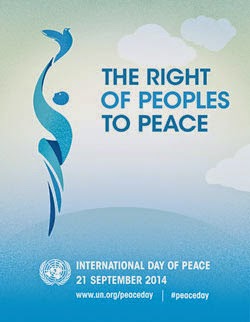
And the first reflection is this: peace is the normal condition of humanity, just like health. There is so much plain, simple, decent behavior around, so much mutual aid, a helping hand, companionship, friendship, good neighborhood when bad luck strikes at its worst. And we sense mutuality, unquestioning reciprocity; not always but mostly.
Go to an airport, stay close to where they come out, arrival, and are met by their nearest–watch the embraces, the warmth, the eyes glittering, the smiles, laughter. There we are. Harmony, resonance–with the occasional deep, joint sadness, sorrow; something has struck.
Go to a restaurant, not too stiff, formal–more ordinary eatery. And you see it again, the pleasure, food, drinks, togetherness, the shared pleasure–the jokes, the smiles.
Most of the time–then some incident, issue arises. Like health: there is so much physical and mental wellbeing if we care to notice it, including our own–then some disease, minor or major, strikes and captures all the attention, indeed of the media. Most of the time most of us live in peace and health. The world is not belligerent, any given year for everybody, just because two countries had a stupid war; nor unhealthy for everybody because of a malaria or ebola, epidemic, however bad for the victims.
Let us keep a sense of proportion. Like in highway traffic, most driver-vehicle-meters driven are by far flawless. Then: an accident. We focus on accident-prone drivers, cars and road stretches like on belligerent states, cultures and structures, to learn (why not also from the best?). But that should not blind us to all the peace and health; even vertical companies, capitalism, often function–but when not, the damage may be devastating for so many for such a long time.
Do we reflect on peace or non-peace? On both, of course.
Peace. That little word, one or two syllables, 3 to 5-6 letters, fred-rauha-mir-peace-vrede-Friede-paix-paz-pace-pau-beke-eirene-shalom -sala’am-shanti-ho ping-heiwa, to mention a few. Short, unassuming, so compelling. Very concrete things to do–some more difficult like handling trauma and conflict, some easily done, simply exuding warmth, love; clothing warm thoughts and feelings in warm words and acts.
But that little word stands for much more and disappearing into the clouds and beyond. “Do not make drawings of me”, it says, “do concretize but that never catches more than a fraction of me. I am the spirit that gives meaning beyond biological life, beyond physical health. I am that which unites you all–“.
The soul of cooperation, not only the give-and-take in the famous “doing to others what you want them to do to you”, somewhat beyond not doing to others what you would rather not have them do to you. There is something flowing, something beyond “goods and services” and “pleasure, pain”. Some kind of medium, ether if you will, in which our relations are embedded, sown with seeds of peace, blossoming into full flowers at ever higher, more complex levels. Positive peace.
Sense that medium grow. A We-ness takes shape. The egocentric doing and not doing to others yield to shared joys and sorrows with others, to egos embedded in a We, Us, to resonance, to true harmony.
Watch that medium expand, from your nearest to a humanity thirsting for compassion; sense their ups and downs, your compassion may touch them. Build bridges in your imagination, to Ruskin-Gandhi’s Unto This Last; not only to the suffering, also to the fulfillment. Let both in. Permit yourself to be touched, to be inspired.
Watch that We-ness deepen, into some kind of fusion. Self and Other become one, if only for the fraction of a moment, a oneness. The ego becomes small; the relations, also past, future, overwhelming.
Concrete peace, or spiritual peace? Both, of course.
Nature. Goethe’s famous “Über alle Gipfeln ist Ruh, Über alle Wipfeln spürest Du, Kaum einen Hauch” is a hymn to nature peace as quiet, windless. That is one nature peace.
Another nature peace. In Spain, up there, are two clearly gendered mountains, huge–Adam and Eve. They exude peace in their eternal stillness, unmoving, yet immensely touching and inspiring. Be it windless or stormy, equally faithful. The guardians are there.
Yet another. A river with waterfall and eddies, a beach with the rhythm of waves, long, rolling in, forever. All is movement, like snowflakes in the wind on a winter day; yet there is rhythm and harmony. The water freezes, the ocean flattens, the snow covers the earth.
It is the Rule of Law, Nature’s laws–maybe one day negotiable with less distance to Nature–our freedom is insight in them (Hegel).
Arts. Here is an effort:
| KUNST OG FRED La oss löftes av kunsten som kunstnerne har löftet den oppover, utover det vanlige utover alldagen slik at vi kan skue langt utover grenser og klöfter i vårt uryddige menneskelandskap inn i andre öyne som også er blitt löftet utover det vanlige for å forenes i fred. | ART AND PEACE Let us be lifted by the arts like the artists have lifted them upward, outward, beyond the ordinary beyond the run of the mill; making us see far beyond borders and cleavages in our untidy human landscape into other eyes that also have been lifted beyond the ordinary to be united in peace. |
____________________________
Johan Galtung, a professor of peace studies, dr hc mult, is rector of the TRANSCEND Peace University-TPU. He is author of over 150 books on peace and related issues, including ‘50 Years-100 Peace and Conflict Perspectives,’ published by the TRANSCEND University Press-TUP.
This article originally appeared on Transcend Media Service (TMS) on 22 September 2014.

This work is licensed under a CC BY-NC 3.0 United States License.
Friday, September 19, 2014
Astute reader catches financial disclosure glitch
by Larry Geller
It seems that some dedicated good government advocates are paying attention to the nitty-gritty of financial disclosures for the 2014 election. Good thing, because the number of filings, as usual, seems to defy review by the Ethics Commission. If only the Legislature would increase their budget…
An astute reader forwarded the following catch:
Kent Fonoimoana is running for Hawaii State House District 47. His financial disclosure form was filed, according to the date stamp, on July 21, 2014. The deadline to file was July 18.
Fonomoana was in good company:
Gov. Neil Abercrombie and Lt. Gov. Shan Tsutsui were among the 2014 candidates for office who failed to file their financial disclosure statements on time and will face a $25 fine from the state Ethics Commission, the commission said Tuesday .
The financial disclosure statements include information about a candidate's sources of income, business ownership interests, debts, real property ownership, officer and director positions in various businesses and other financial information.
A total of 130 of 203 candidates filed by last Friday's deadline, the Commission said.
[Star-Advertiser Political Radar, Missed Deadline, 7/23/2014]
I submit that a system in which 64 percent of candidates are disregarding the law isn’t working very well. Check out the complete list of candidates who missed the filing deadline at the link.
We don’t know if any fines were assessed, and heck, who cares about a $25 fine (or so it appears).
So now the forms are filed and posted on the web.
I’m glad that some people are going through this mountain of data. I know the Ethics Commission may not appreciate my criticism, but I would think that crowdsourcing the vetting of the forms is not the best thing to do.
Take Mr. Fonoimoana’s form. I checked the website, and it is still the current form listed, so it appears it has not been amended.
Here’s the problem:
Creditors are listed, but no amounts given. And in this particular case, shouldn’t potential voters know if this candidate has a tax issue?
If you’ve seen similar articles I’ve posted earlier, you’ll remember that each filer signs the bottom of the form. Here’s the signature block for this one:
CERTIFICATION: By checking this box or signing your name on this form, you signify and affirm that you are the person whose name appears as the "Filer” above and the information contained in the form is true, correct and complete to the best of your knowledge and belief. You further certify that you understand that there are statutory penalties for failing to report the information required by Hawaii law.
As to statutory penalties, are they ever levied?
Remember, 64 percent of filers didn’t even bother to file by the deadline. Compliance with the law doesn’t seem like a priority. Maybe because there’s no downside to non-compliance.
Will the Ethics Commission impose the “statutory penalties?”
With the money, they could hire a part-timer to go through the forms and check them out (hint). (they’re probably not allowed to do that)

Calvin Say residency case got complicated yesterday
by Larry Geller
Even apparently simple things can get complicated when a question of law is involved.
For example, does Calvin Say live in his district or not? Should be easy to figure out, right? No way.
Yesterday, in Judge Karen Nakasone’s courtroom, it got very complicated. After reading the briefs and hearing all sides argue. Judge Nakasone announced that she will take the matter under advisement and rule no later than September 30.
I have little to add to Chad Blair’s report, Judge to Rule by Sept. 30 on Dismissal Motions in Calvin Say Residency Case (Civil Beat, 9/18/2014).
But if you’d like an idea of how complicated the decision will be, how about this.
The House is arguing that it alone may determine the qualifications of its members. The plaintiffs argue that the court also has jurisdiction, and since the House has declined to review the matter (see the documents attached to the Civil Beat story), the court has jurisdiction (there were plenty of other arguments on both sides).
Among the several issues is one you may try to resolve yourself. You be the judge. Here it is, in my own interpretation, see what you think.
Check out the Hawaii state constitution, Article 3.12, Organization; discipline; rules; procedure
Each house shall be the judge of the elections, returns and qualifications of its own members and shall have, for misconduct, disorderly behavior or neglect of duty of any member, power to punish such member by censure or, upon a two-thirds vote of all the members to which such house is entitled, by suspension or expulsion of such member….
Compare this with the language in Article 3.19 Impeachment
The house of representatives shall have the sole power of impeachment of the governor and lieutenant governor and the senate the sole power to try such impeachments, and no such officer shall be convicted without the concurrence of two-thirds of the members of the senate.
The Hawaii State Constitution uses the word “sole” here. It’s pretty clear that a court would have trouble impeaching the governor or lieutenant governor. That’s the effect of the words “sole power.” Court: forget about it. Only the House has the power to impeach. The word “sole” appears in a couple of other places in the constitution.
Notice in the earlier snip, the word “sole” does not appear. The usage appears to be not much different from much of the rest of the constitution—prescriptive language. For example,
The legislature shall convene annually in regular session at 10:00 o'clock a.m. on the third Wednesday in January.
In other words, the constitution says what should happen.
(This is my interpretation of the plaintiff attorney’s argument, not his).
And when given the chance, the House declined to consider the question brought before them this time. So can’t the court take it up? The constitution did not give the House “sole” power in this, it seems.
Or does it? You can be the judge.
That’s just one example (as I think I understand it) of the debate that ensued yesterday. If you weren’t there, you missed some profound arguments. They must have been profound because I don’t understand them. I don’t know how to weigh the comparative force of territorial laws. I have no clue what the many citations might really mean.
Poor judge. Tough job.
I went into the courtroom in blissful ignorance and emerged profoundly confused.
This is not easy stuff.
Scrutiny of Honolulu police handling of Cachola incident could lead to needed reforms
by Larry Geller
One must seize the moment. The time to scrutinize police violence, including domestic violence, is now. The place for us to start is right here in Honolulu.
Perhaps the national focus on domestic violence triggered by NFL mishandling of the Ray Rice incident, combined with recent memory of police excesses in Ferguson, will lead to greater focus on the deeper implications of the current incident at Kuni’s Japanese Restaurant involving police Sgt. Darren Cachola.
Yes, the actions of this police officer are central to the issue, but police treatment of the incident is now front and center as well.
Publicly available video plays a critical role in each of these domestic violence incidents, and without it, the alleged perpetrators would likely never face the music. If there is an upside to pervasive surveillance, it is that sometimes it can serve a valid social purpose.
When we watch a video appearing to show a woman struck until she falls unconscious in an elevator, or that appears to show an HPD officer repeatedly striking and pursuing a woman in a restaurant, it’s tough to deny that something questionable has taken place. These videos cry out for investigation, and yes, where appropriate, arrests.
Given the video evidence, why has HPD not yet arrested the alleged perpetrator? Why was he not arrested immediately?
Hawaii law allows police to arrest someone if they have cause to believe domestic violence occurred. The law does not require the police witness the violence. The law does not require visible injuries on the victim. The law does not require a statement from the victim. In fact, anyone trained in domestic violence knows that victims will frequently refuse to accuse their abuser out of fear of retaliation.
At least two witnesses were on the scene, shown in the video coming to the woman’s rescue. However, even if the officers disregarded their statements and believed that this was a mutual fight, public fighting is still against the law –it’s a petty misdemeanor crime.
Failure to take any action against this officer was not justified.
[senatorlaurathielen.com, Public Trust is the Basis for Granting Police Enforcement Powers – What Do You Do When Trust is broken?, 9/11/2014]
Echos of Clyde Arakawa case—special treatment given to fellow HPD officers
In the current Cachola incident there is a question of why responding officers did not file a report. Ian Lind questions police training as part of his article reviewing why victims often stand up for their attackers.
Was Cachola given special treatment because he is an HPD officer? It would not be the first time officers have taken care of their own.
Back in 2000, HPD officers arriving at the scene of a fatal accident afforded fellow officer Clyde Arakawa special treatment.
Police initially insisted that the investigation was handled the same as any other case, but [Honolulu Police Chief Lee] Donohue later acknowledged that Arakawa received special "courtesies" not given to other suspects in fatal crashes. Donohue promised to take disciplinary action if any was warranted.
After the 11:15 p.m. collision, the police union notified a lawyer, who appeared at the crash scene, and Arakawa was allowed to roam freely without being handcuffed or under supervision.
Donohue had said that the courtesies would not jeopardize the criminal investigation.
Arakawa was later charged with manslaughter. He is accused of causing the death by driving drunk and running a red light.
[Honolulu Advertiser, HPD disciplines dozen in Arakawa crash case, 1/26/2002]
and
Back in 2000, [HPD Lieutenant Colin] Wong received a six-month demotion after he was caught on camera putting his arm around fellow police officer Clyde Arakawa soon after Arakawa had been involved in a fatal motor vehicle collision on the Pali Highway. Arakawa, who was drunk at the time of the crash, was later convicted of manslaughter in the death of 19-year-old Dana Ambrose.
[Star-Advertiser, HPD lieutenant arrested for alleged DUI, 3/30/2013]
Although at least a dozen officers were reported disciplined in the Arakawa case, details were withheld from the public. From the first snip above:
Donohue declined to answer questions about the officers, citing a collective-bargaining agreement with SHOPO…
Refusing to meet with legislators further damages public trust
The latest news indicates that the Hawaii State Women’s Legislative Caucus has been denied a meeting with our police chief (see: Civil Beat, Hawaii Women Lawmakers Slam Police Chief for Canceling Domestic Violence Meeting, 9/17/2014).
I wonder if he knows what that denial could lead to.
As Senator Thielen wrote on her blog, public trust is the basis for granting police enforcement powers. Trust has clearly been damaged by declining to meet with state and city legislators.
Likely, that will have consequences. And it should.
Just as the Legislature this past session took away HPD’s immunity from prosecution if they have sex with prostitutes, new laws may be needed to provide transparency, public accountability, and to improve training in handling domestic violence incidents.
Related:
- Will HPD Seriously Confront Domestic Violence Within Its Ranks? (Civil Beat, 9/11/2014)
- Honolulu Police Chief Vows He Won’t ‘Cave In’ To Political Pressure (Civil Beat, 9/18/2014)
Thursday, September 18, 2014
MRAPs for school districts? Colbert shows why they need to defend themselves
by Larry Geller
The San Diego School District needs their MRAP (Mine-Resistant Ambush-Protected vehicle) to defend themselves, according to Stephen Colbert. Against what? Watch the video.
(click on the thingy at the lower right for full screen)
Related:
The excuse given to the public was that the same vehicle used to patrol the streets of Baghdad will be used to store medical supplies and teddy bears. The reader should notice that this is not an article on The Onion.
“There will be teddy bears in the vehicle. There will be trauma kits in the vehicle in the event any student is injured and our officers are trained to give first aid and CPR.”
The Chief seems to believe that the MRAP will roll out whenever a student in the district is injured. This is, of course, a lie to sell the idea of militarizing a school police department to the public.
[theantimedia.org, School District gets MRAP to Store “Teddy Bears”, 9/18/2014]
CA releases 1033 program data<br>Los Angeles School Police Department received three grenade launchers
From the above link, what the LA school district police department received:
Los Angeles School Police Department
61 assault rifles, all M16 5.56 mm
3 grenade launchers
1 mine resistant vehicle (MRAP)
That’s right, 61 assault rifles in a school district, etc. The existence of that arsenal alone presents a threat to public safety. I hope they don’t store the stuff in school lockers…
Today on Town Square: community activists' response to Honolulu's plan for the homeless and comparison to best practices
by Larry Geller
Tune in today to Town Square with Beth-Ann Kozlovich and guests—as they delve into the city’s plan to manage its homelessness crisis. 5-6 p.m. 89.3 FM or on your cable someplace, or stream it from hawaiipublicradio.org. Lots of ways to listen. And you can call in with your own questions or comments.
Guests will be:
Jenny Lee, Staff Attorney, Hawai'i Appleseed Cemter
Kathryn Xian, Executive Director, Pacific Alliance to Stop Slavery
Matthew Doherty, Director of National Initiatives, The United States Interagency Council on Homelessness
The commercial media have done little more than echo what the Mayor and City Council say they will do.
Tune in to learn more.
Find out how Honolulu’s plan fits with what other municipalities have done starting years ago, and how their experiences have come together to form well-established best practices for assisting those living outside to move into stable housing and to provide for themselves.
It takes time, and it takes a conversation to understand Honolulu’s plans and how our tax money is being spent. Listen, form your own opinion. Call and say it on the air.
Wednesday, September 17, 2014
Can a violent brain be turned on and off?
by Larry Geller
The Star-Advertiser ran this political cartoon this morning. Wish I had seen it before writing yesterday’s article, Does playing football damage brains and contribute to domestic violence? (9/16/2014). It’s a copyrighted cartoon by John Cole dated 9/10, drawn for the Scranton Times-Tribune.
In words, I’d say it asks the question of whether a violent football player can be switched on for games and off when he is supposed to be a model citizen.
Add that in to my question about brain damage leading to aggression, violence and loss of impulse control. In other words, even if a football player had such a switch installed on his head, would it work? With a damaged brain, can violence be switched on and off?
Even if we knew the answer, football will remain the national religion sport, and so change will be very hard to achieve. Perhaps impossible.
Sadly, this religion sport seems to require a component of human sacrifice to appeal to the masses.
Johan Galtung’s view from Europe: The Long Shadows of History
“
USA, change! Or else.
”
The Long Shadows of History
15 September 2014
by Johan Galtung, 15 Sep 2014 - TRANSCEND Media Service
As Carl Gustav Jung said, and the Chinese before him–the shadows are long and dark. Jumping does not help, they follow us. Thus, the USA is wrong in believing that they can get away with the misdeeds of the past, that people will forget; they are not historians. Moreover, when done by the USA, deeds are not evil, at worst “tragic”, and not only for the victims but also for the perpetrators accused.
Take Ferguson, Mo. and the militarization of the US police. The s-word “slavery” is whispered in the shadows (and shouted in books like Walter Johnson, River of Dark Dreams, Slavery and Empire in the Cotton Kingdom). It was forced labor to put it mildly, with chains and whips. And in the world No. 1 in prisoners, the USA, we find a disproportionate number of blacks for petty crimes on forced labor with chains–sold to employers; prisons even on the stock exchange.
Take the indigenous, the g-word “genocide” is whispered, and the e-word is shouted in G. C. Anderson Ethnic Cleansing and the Indian.
Shadows take shape in the collective memory, the conscious part. In the deep culture: “one day they will come and do to us what we did to them”; making the fear of a major revolt self-fulfilling.
The darkest shadows are inside the collective subconscious. The feeling of being on the wrong side of history, not only losing wars and an empire, has come to many, even if not yet to that bipartisan Congress. Despair, apathy, suicide; individually or as mass murder. A feeling of sliding downhill in the country used to always outdo itself. The leadership tries to find somebody outside to blame, revives Russia from the Cold War, ever more Muslims from the war on Islam declared by NATO in 1992 as the successor to the Cold War–all the time against the shadows whispering, watch yourself USA, these calamities are basically of your own making. You may jump at others, execute them–but the shadow follows you faithfully, growing darker.
How does one process dark shadows?
By confronting them. Submitting the USA to International Truth Commissions on the conquest of America from 1607 to1620, and on the slavery; White against Red, and White against Black, could help.
Commissions on above 240 interventions abroad so far, starting with Jefferson, would be tremendous. Denials bring the USA nowhere, but there is room for explanation, for why, in light of the values at the time. Korea, Vietnam, the Muslim world, Iran, Palestine, Somalia, Afghanistan-Pakistan, Iraq, Syria and ISIS to mention a few, would be quite something as the present produces shadows for the future. A “strategy” without understanding what produced the violence is empty. And, while “destroying ISIS,” new movements will emerge; how many?
Make no mistake, there is no way in which the world will forget the past; surviving, even if repressed, as deep culture, collective nightmares. And politically as efforts to spy on the whole world.
The 3C, Confession-Contrition-Compensation? Would help, would also help to heal the martyred, tortured US soul; there is such a thing. It would do good to both sides, all sides, and cost little, except psychologically, to climb down from exceptionalism to the moral abyss of confrontation with past and present. But then the shiny side, gaining a moral high ground being capable of distancing itself from the misdeeds of the past, not being forced to do so by being beaten.
Imagine a “shadows around the world, unite!” movement. The Red and the Black of the USA, invoking their ancestors; the millions touched directly by the more recent US wars and coups in Latin America, Africa, the Koreans, Vietnamese, countless Muslims in Asia–imagine a Coalition of the Unwilling to Take It Any Longer; joined by a couple of million spied upon, read, listened to. Stop it or else–or else what? Violence? No–not even from the half of humanity that this year will be members of the Shanghai Cooperation Organization, SCO.
Worse. “USA, you like issuing pariah certificates to countries; down and out. Our certificate to you says irrelevance–we find it impossible to cooperate with you. Your track record is too dark. We sense your finger-, foot-, body- and soul-print in the bad turn of the financial economy, terrorism state and non-state, the US-Israel take on Palestine and on Muslim states such as Libya, Iraq-Syria, Pakistan–Afghanistan, and in Korea, China, Japan, Africa and Latin America. You always too quickly resort to violence, no good at deeper causes. We cannot force you to change, you have to will that yourself. But we can take the ball out of your court and play it ourselves. Many of us have already started, many more will follow.”
Does the USA really have to submit to all those international commissions to get off the hook, to dozens of Bishop Tutus, who actually goes further in his famous: “If you are neutral in situations of injustice, you have chosen the side of the oppressor: If an elephant has its foot on the tail of a mouse, and you say that you are neutral the mouse will not appreciate your neutrality?”
No, not by submission but by inviting them, pro-actively. A good start would be international commissions on Eastern Ukraine and on the downing of the Malaysian flights MH17 and MH370. Make no mistake, refusal to accept international commissions-tribunals, for instance over the role of Afghanistan in 9/11 2001, is self-incriminating.
Dark shadows from history are not a US monopoly. Colonialism, and not only Western, pervasive and persistent, was slow to die, and there are still some residues. But the USA stands out today, and has done so for a long time. Look at the list of problems mentioned above, starting with the finance economy, and think the USA away, as irrelevant: it helps identifying solutions for all of them. Leadership should be collective, like BRICS; leadership should never be one country, or one person.
USA, change! Or else.
___________________________________
Johan Galtung, a professor of peace studies, dr hc mult, is rector of the TRANSCEND Peace University-TPU. He is author of over 150 books on peace and related issues, including ‘50 Years-100 Peace and Conflict Perspectives,’ published by the TRANSCEND University Press-TUP.
This article originally appeared on Transcend Media Service (TMS) on 15 September 2014.

This work is licensed under a CC BY-NC 3.0 United States License.
Tuesday, September 16, 2014
Does playing football damage brains and contribute to domestic violence?
“
America is a football crazed nation, yet the long term affects of what takes place on the field have been mostly overlooked.--Dr. Amen: Momma Don’t Let Your Babies Grow Up To Be Football Players
”
“
If you began playing football in high school, the doctor says, you have a higher risk of suffering health problems involving the brain later in life. Among the ailments that may be linked to football is chronic traumatic encephalopathy, a progressive degenerative disease associated with repeated brain trauma. Symptoms, which may occur early or years after a brain injury, include dementia, memory loss, aggression and depression. Amen has also found violent behavior, obesity, mental illness, and suicide statistically common in populations of former players.--Daniel Amen, Newport Beach Brain Doctor, Says NFL Must Get Its Heads Examined
”
by Larry Geller
[Image credit: By Patrick J. Lynch, medical illustrator [CC-BY-2.5 (http://creativecommons.org/licenses/by/2.5)]
This is not something I follow, but I do wonder if people are checking into the possible (likely?) concern that repeated violent head banging in sports can lead to  brain damage that in turn increases violence including domestic violence. And if so, what to do about it?
brain damage that in turn increases violence including domestic violence. And if so, what to do about it?
Football seems to depend on increasing violence. Isn’t that what the fans are cheering for, what drives patrons of sports bars into shouting frenzies across the country? So if the sport itself leads to “conditioning” the brain for violence, why would the NFL ever intervene?
Aside from psychological conditioning, banging a soft brain repeatedly against a hard skull can damage areas responsible, for example, for impulse control.
The two pullquotes above are a bit old. I attended a talk by Dr. Amen long ago in Honolulu. He is interested not only in detecting and preventing brain injury but in remediating the harm caused that otherwise would be long lasting. 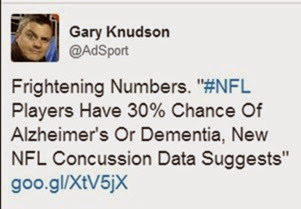
Dr. Amen showed us colored SPECT scans that were very scary—not just of brains damaged by physical injury but also by drugs. and of brains eaten out by Alheimer’s.
There were some similarities in the pictures: areas of the brain that were no longer functioning appeared as dark holes where there should have been activity.
Can we say that the player who knocks his domestic partner unconscious has not been aided and abetted by the purveyors of NFL violence-for-profit? (And what about the health of her brain??)
If football is the national religion sport then shouldn’t we all be calling for reform?
Sure, I know, it’s not very likely. But that’s not a satisfactory answer.
Monday, September 15, 2014
Change in time for Calvin Say hearing
by Larry Geller
For those of you following the legal challenge to former Speaker Calvin Say’s place of residence and hence his eligibility to hold his seat in the Legislature, there has been a time change for the Thursday hearing. Change your calendar.
Judge Nakasone has just moved the time of the hearing on Thursday to 2:00 p.m.
for Calvin Say's motions to dismiss or for summary judgment and the House's
motion to dismiss for lack of subject matter jurisdiction.
The place is the same—the fifth floor of the courthouse on Hotel and Alakea Streets, not the one on Punchbowl. When you get to the fifth floor, just look for Judge Nakasone’s name on the courtroom, turn off your cellphone ringer, and go inside.
Correction / Ethical issues related to homeless tent camp
by Larry Geller
This morning I was a guest on HPR’s The Conversation. I’m not sure exactly what I said, but someone who listened to the program told me that I said that the Sand Island site contemplated by the city for their planned tent camp for the homeless is contaminated. That’s not what I meant to say, and it’s not accurate. The site hasn’t been tested, so we don’t know what might be there. The list of contaminants that I read was from a document describing contaminants and potential contaminants from an adjacent or close by site.
It’s important to be accurate, and if I misstated, I regret the error.
As I understand the state approval granted Friday for use of the site, it is contingent on the site being tested and on Department of Health approval. However that happens, the tests should be public documents, so we will find out what’s on or under the ground when they are completed.
For those of you who might not have heard the program this morning, I think two new concepts were introduced.
1) I suggested there may be ethical issues if the city pushes those people moved from the streets of Waikiki into housing ahead of those already identified as candidates—and I’m told that there is already a list of about 275 people compiled as a result of the agreed intake process. (Note that intake, or “triage” as the city has described it, can be done anywhere, it’s not necessary to move anyone to Sand Island to determine eligibility for Housing First. Intake can be done in most any room in the city.)
2) In answer to Beth-Ann’s question, I replied yes, I think, the scheme could backfire on the city if it should turn out that people sitting on the sidewalk in Waikiki are given priority for a housing program. Anyone interested in getting into a Housing First unit when they become available might flock to Waikiki and sit down, hoping to be bused to Sand Island to begin the process. This is assuming that Mayor Caldwell signs the bill that limits the enforcement area rather than the one that is island-wide. Just thinking out loud on this one. There could be so many complications to this process, and the money spent is not going towards housing.
Friday, September 12, 2014
Board of Land and Natural Resources approves city’s Sand Island homeless camp subject to list of conditions
by Larry Geller
After hearing testimony overwhelmingly opposed to the city’s plan to create a homeless camp in land in isolated Sand Island, the Board of Land and Natural Resources voted to approve the application subject to conditions.
There was some positive testimony, but those who opposed noted that the city had not had the area tested for the long list of chemicals, pesticides, heavy metals and other contaminants discovered in Department of Health reports for the immediate area. Others noted cultural issues, others raised security issues.
The board members did listen and asked relevant questions. In the end, they approved, but with the following conditions:
1) Approval of the Department of Health of suitability for intended use
2) If the city should ask for a longer term than three years, the environmental exemption will no longer apply
3) The City and County are responsible for adequate security
4) The City and County are responsible to follow through with the representations they have made about getting more public input prior to occupancy
5) A quarterly review shall be submitted to the Chair on the progress of the project
6) Subject to the decision on the contested case hearing
In my testimony I pointed out that the application for the lease and immediate right of entry was misrepresented to the Board by the city. The purpose, as given in the application, is:
PURPOSE:
Temporary Mobile Access to Services and Housing (TMASH). A temporary triage for services and housing to determine the needs of homeless individuals / families based on their circumstances. The City's on-site contract service providers will assess and evaluate the vulnerability of homeless individuals / families to prepare for Housing First placement, while providing them with temporary shelter.
A board member asked about the meaning of the word “triage.” I and others described our understanding that it had military origins, where the wounded were assessed and prioritized for treatment (or for no treatment, alas).
I pointed out that triage could be done in any room in the city. The hearing room, for example. People could come in the side door (leaving dogs and cats outside), over here would be the social workers, over here the RNs, then the housing specialists, and finally the case managers (just as an example). Then they can go out the back door with their housing voucher or other papers.
There’s no need for the Sand Island lot for triage. What the city described with its slide show today was a tent city to be occupied by the houseless. They want to be able to say, in order to get the various punitive ordinances passed into law, that there is someplace to relocate the houseless living in Waikiki.
Homeless camp is in evacuation zone
by Larry Geller
While the Board of Land and Natural Resources were in their executive session this afternoon considering the city’s application to use an unimproved area on Sand Island as the location of their planned homeless camp, I thought I might check the evacuation maps for Sand Island.
Yup.
In addition to whatever other problems the camp may have, it’s in the Zone.
(click for larger)
So when the weather is hot and dry, the campsite, with no shelter from the sun and hot asphalt below, will be sweltering. If there is a flood or tsunami, the question will arise how to get people out of there—presumably most will not have any cars.
Even when it’s just ordinary rain, imagine, as one of the Board members did, what it will be like to be in a tent on flat, flooded asphalt. Just for that reason I would think the proposed plan is unsuitable for human habitation. But the BLNR did approve it today.
Thursday, September 11, 2014
No community buy-in on city homeless camp plan
“
I'm sure local officials will try to counter that locking up poor, homeless people isn't their goal. Oddly, they seem pleased with themselves because they are providing a tent city with some services for the homeless and billing their "plan" as Housing First and even "supportive housing."
The organization I represent has a national reputation creating what is actually supportive housing. Supplying temporary tents on an island — which conjures up offensive scenes of World War II internment camps — fits absolutely no one's professional definitions of Housing First or supportive housing. It, however, does give a whole new meaning to pitching your spin.—op-ed by Deborah De Santis, Star-Advertiser, 9/11/2014
”
by Larry Geller
The idea of a proposed homeless camp on Sand Island may appeal to residents of Waikiki, but at last night’s informational meeting, it did not sit well with several community members.
City Managing Director Ember Shinn and her staff presented an informational hearing last night at the cafeteria at Puuhale Elementary School at which they presented their plan to those who attended. The auditorium was almost fully packed, largely with community members from the area and other parts of Oahu, but also with advocates, some state legislators and city officials.
At the meeting, attendees were told what the city’s plan is. There were no handouts, only a powerpoint presentation and an easel at the rear of the room with this clearly hastily-prepared Google Earth pasteup (click for larger):
A very good account of the meeting was posted by Civil Beat, here.
The Star-Advertiser also covered the event, but perhaps space was limited and of course the paper was about to go to print, so the Civil Beat account is both more complete and more accurate (for example, in response to questioning about pollutants, CB noted that the city responded that they would cover the site with asphalt, not concrete, as the S-A reported). [So the kids are supposed to play outside the tents on hot, stinky asphalt?? Whose great idea is that?]
Doug Matsuoka was there recording video, so a record of the meeting should be posted soon. In the meantime, some observations.
So... what to call the camp?
In City Managing director Ember Shinn’s introduction she objected to the characterization of the site as an internment camp, noting that her father (?) was interned there at the start of World War II. My thought: well, I can understand that. But then, she might also think of how the people whom the city wants to remove to this camp site will feel about being put there, and of course, what it says about a city administration that is willing to put them there.
Homeless will experience living in a gated community
Some members of the Sand Island or Kalihi communities expressed concern that residents commuting to the site will defile their neighborhoods, or spoil surfing which is popular off the island. In response, the city noted that there will be security, and offered to clean up anything reported to them. They pointed to the guard house and roving security present in the camp at all hours.
Ok, so we now have an alternative to the term “internment camp” that Ms. Shinn objected to: “gated community” may be more accurate as well. At the right of the photo above is the guardhouse that will challenge anyone entering the property, it was explained.
Site pollution issue skipped in presentation
The question of site pollution was not raised during the city presentation, a notable omission. They responded only when questioned by activist Kathryn Xian.
Considering the press that this issue has achieved, you’d think (well, I think) it should have been covered rather than covered up in the city’s presentation.
Failure to consult with houseless residents can doom city’s plans
Last night’s meeting was to “tell” or perhaps “inform” the community of the city’s plans. We heard toward the end that an RFP for the site has been issued. What we did not hear was that the community was involved in the planning.
Indeed, in her introduction, Ms. Shinn expressed great pride that this is the first time that a city has attempted this kind of a project on its own—and that prior examples of “tent cities” or “safe zones” were planned and organized by communities, not by cities.
To the extent that they might have succeeded, perhaps it is because they were planned by the community itself and not by a municipality that they did so.
It amazes me when the city is forced to withdraw plans because of community objections. One can blame it on “NIMBY”—or alternatively, admit that imposing a solution on a community without adequate involvement or consultation is an intrusion, not a solution.
The city’s exclusion of those community members most affected from its plans to criminalize homelessness and to isolate them on hot asphalt in a camp on a detached island may ultimately frustrate those plans and stick taxpayers with the cost of the experiment.
Unavoidable increase in street violence?
An intrinsic side effect of the city’s plan is that of necessity, as they stated, they will screen and exclude anyone with a record of violence. They would have to do that. No argument.
But wait until the residents of Waikiki learn that as people are “removed” from their streets, they are “left with” the most violent still there.
Involving the community is not rocket science
The Daily Show regularly lampoons misguided plans with a meme in which its “correspondents” assemble community members on a kind of bleacher set—say, three ascending rows of three people each. The correspondent then discusses the issue, and finds that everyone is opposed. Or, perhaps, if it is racially-oriented topic for example, that only the white guys agree. The lampoon is very effective.
There are plenty of ways to involve the community in planning. First and foremost, one might place actual homeless people on the planning groups. But in terms of process, there are plenty of options. One can hold several guided community meetings to listen, form and review plans. One can gather a smaller group first to suggest alternatives. Anything would be better than holding informational briefings to “tell” people what you are planning to do to them or in their neighborhoods.
Consensus building is a well-known art. It doesn’t mean everyone in the community agrees, but it is the pathway to development and acceptance of successful community planning.
This homeless camp isn’t necessary anyway
Supplying temporary tents on an island — which conjures up offensive scenes of World War II internment camps — fits absolutely no one's professional definitions of Housing First or supportive housing.
[Star-Advertiser p. A9, Penalizing homeless won’t work; supportive housing will, 9/11/2014]
There is no place in a Housing First program for anything but housing first. Even if the city succeeds in transferring some people into the camp, they are working against, rather than with, the model. And at what cost?
At the meeting, the city confirmed that the camp will be designed to handle only 100 people, and that they will consider it a success if there are 40 occupants.
At least one questioner confronted the presenters with the costs of putting all this into place for just 40 (or 100) people, given the large number of homeless on Oahu. [Note that expenses for plastering the ground with asphalt aren’t yet in any budgets because the city neglected to consider potential pollution at or near the site.]
Neither the city administration nor the City Council (with the possible exception of councilmember Breen Harimoto) apparently understand the basics of Housing First.
The internment camp gated community was initially dubbed as “temporary Housing First.” Yet there is no such thing.
Housing First is an approach that offers permanent, affordable housing as quickly as possible for individuals and families experiencing homelessness, and then provides the supportive services and connections to the community-based supports people need to keep their housing and avoid returning to homelessness.
[quoted in Framing the problem: Honolulu government does not understand Housing First, 9/11/2014]
Basically, the city needs to convince the public that the punitive measures it is moving to enact into law—which criminalize the homeless but do nothing to assist them—are not so bad because it is providing them with an alternative to the streets.
But the “alternative” would accommodate as few as 40 people. The questioner pointed out that 40 is close to negligible.
The city apparently plans to have buses accompanying the police sweeps to take people to the Sand Island camp as an alternative to police action (if they do that, they may likely open the door for legal action).
The city administration revealed its priorities in its RFP for its Housing First plan. Here is the very first objective of the program (p. 15):
To alleviate the impacts of unsheltered homelessness on residents, businesses, and visitors in the City and County of Honolulu through the creation of appropriate housing opportunities that will facilitate the transition of unsheltered homeless persons and families from public and private property not meant for human habitation in targeted neighborhoods, to appropriate housing in the community.
This is not a client-centered approach. But then, the city is trying to take care of businesses and developers first, they have made it clear.
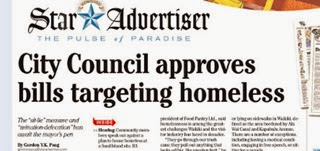 This morning’s Star-Advertiser front page headline seems to recognize this: “City Council approves bills targeting homeless.” Yes, targeting. They are being targeted.
This morning’s Star-Advertiser front page headline seems to recognize this: “City Council approves bills targeting homeless.” Yes, targeting. They are being targeted.
Kailua resident suggests a better use for buses
During questioning, a Kailua resident noted that there are homeless people sleeping on the streets of Kailua also, and asked why the city doesn’t put the support services it described for the camp onto a bus and come into the neighborhood to provide support to the homeless right there in Kailua?
See, when the community has an opportunity, new ideas can result.
Is there any chance that the city will do that? Not likely.
Another community suggestion utilizes container housing, central services, and a wall of storage surrounding the facility
Someone went to the trouble of making and bringing a model. Of course, any idea has pros and cons, but this illustrates that the community is very capable of working cooperatively on an issue.
The city should focus on getting Housing First accepted and underway
It’s 2014, and Honolulu is not in the ‘vanguard” of Housing First as Ms. Shinn expressed at a City Council meeting. It has yet to begin, while other states reported positive data as early as 2004. We need to catch up.
The Kailua bus idea (for example) may have merit, but it depends on the city wanting to do something for rather than to its homeless residents. In any case, Housing First should be first because it is proven to work. Of course other worthwhile ideas could be considered as well that don’t get in the way.
The city isn’t at that place yet where it is working hard to alleviate homelessness or poverty, or to keep individuals and families from falling into poverty.
Framing the problem: Honolulu government does not understand Housing First
“
Housing First is an approach that offers permanent, affordable housing as quickly as possible for individuals and families experiencing homelessness, and then provides the supportive services and connections to the community-based supports people need to keep their housing and avoid returning to homelessness. Housing provides a foundation from which a person or family can access the services and supports they need to achieve stability, begin the recovery process, and pursue personal goals.—United States Interagency Council on Homelessness
”
by Larry Geller
Hawaii Appleseed has gone above and beyond the call in making information about poverty, homelessness and potential solutions available. Here is a tweet from this morning (click for the report).
The article is not too long, informative, and easu reading. At the end are links and references for further reading.
As you read, note that Honolulu’s RFP for what it refers to as Housing First, includes practically none of the points raised by the article. One reference on interventions suggests that the community-based programs contemplated by Honolulu are often not enough.
Every citycouncilperson and state legislator might brush up on the concepts by reviewing this article or other plentiful literature on the subject. Unless they understand what they are doing, they will likely be more part of the problem than of any solution.
Tuesday, September 09, 2014
Mom and Pop no longer own the Shop
by Larry Geller
It’s hard to snip even a small part of this article posted this morning:
Small Business Ownership In America Is At An All-Time Low (Activist Post, 9/9/2014)But having accurate data is important, even if it’s very depressing. So ok, a couple of snips, but nothing too deep. For the whole story, please click the link and check out the report it refers to.
On the other hand, I’ll bet that you already know much of this.
According to the Federal Reserve, the percentage of American families that own a small business is at the lowest level that has ever been recorded….
If the economy truly was healthy, this would not be happening. And it isn't as if Americans are flooding the labor market either. As I detailed yesterday, the labor force participation rate in this country is at a 36 year low.
As David Stockman recently so aptly put it, outside of health and education the U.S. economy has not produced a single job since mid-2000 even though our population has grown greatly since that time... that outside of health and education there has not been one net new job created in the American economy since July 2000! Yes, not a single new job—as in none, nein, nichts, nada, zip!
Hmmm… if you want to be depressed by some statistics and charts, do click over to David Stockman’s article as well.
Let’s recognize what works to remediate homelessness, and do more of it
More than 90% of families and 75% of singles remain housed after one year
”
by Larry Geller
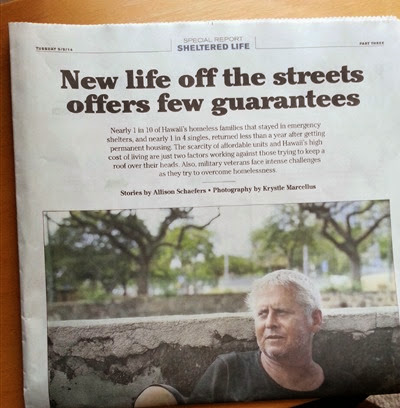
The third and last part of a Star-Advertiser series, “Special Report: Sheltered Life” appeared in this morning’s paper. It’s headlined:
New life off the streets offers few guarantees
Nearly 1 in 10 of Hawaii’s homeless families that stayed in emergency shelters, and nearly 1 in 4 singles, returned less than a year after getting permanent housing. The scarcity of affordable units and Hawaii’s high cost of living are just two factors working against those trying to keep a roof over their heads. Also, military veterans face intense challenges as they try to overcome homelessness.
[Star-Advertiser, p.1, New life off the streets offers few guarantees, 9/9/2014]
If that’s the sub-head, then, where did I get the pull-quote above, which illustrates the same numbers but from a vastly different point of view?
Over breakfast coffee, Nanette grabbed a pen and paper and re-wrote the Star-Advertiser sub-head. She’s a social worker and one who looks for and celebrates people’s natural strengths.
People can be resilient.
What can we learn or deduce from the fact that so many people are helped by moving from shelters into permanent housing? How do we close that 10% or that 25% gap?
1. We really do need affordable housing in Honolulu. But let’s change this to “affordable housing and affordable rentals.”
2. We should run, not walk, to getting a real Housing First program started.
3. As long as the Mayor and City Council focus on punitive measures, putting their time and effort into criminalizing homelessness, they are not contributing to the solution….
4. … in fact, criminalizing the homeless will only make it harder for them to find and remain in permanent housing and obtain the jobs necessary to stay there.
One might also add, though it’s not implicit in the numbers above, that both the state and city must work to implement policies that work to prevent throwing more people out into the street. These measures might include rent regulation or stabilization, and the restoration of cuts to state mental health services that turn people out onto the streets.
Nor is anyone fooled by Mayor Caldwell’s “compassion.”
As the Civil Beat editorial board posted this morning:
It’s our own failure to provide adequate support to people suffering from financial crises, mental illness, alcoholism or drug addiction that is at fault here. Without adequate treatment programs, counseling and housing alternatives, the sit-lie bills offer the bleak prospect of more homeless people going to jail and accruing fines that they can’t pay.
What’s “compassionate” about that?
[Civil Beat, Criminalizing Homelessness: Reject the Sidewalk Sit-Lie Ban Bills, 9/9/2014]
There’s much more to be said, of course. Please read the Civil Beat editorial in its entirety, and note, at the bottom, who it is that is speaking.
Homelessness is a complex issue, and Honolulu is not alone in facing the numerous problems that need to be solved. It is unique, perhaps, in its sloth in getting started with evidence-based solutions, which has resulted in a problem finally grown too big to be ignored.
9th Circuit hears oral arguments in Hawaii marriage equality suit (audio)
by Larry Geller
The plaintiffs in Natasha Jackson, et al v. Neil Abercrombie, et al have already married. Hawaii has now legalized marriage equality and marriages are taking place.
The parties now agree. So this case should be moot, right?
Yet the Hawaii Family Forum, as intervener, argued, not quite yet. The Supreme Court could still strike down Hawaii’s law.
Of course, it didn’t sound quite that simple. Check out the audio in the player below, or download a copy to your own computer. While listening, it’s good to keep in mind that all sides in this case submitted briefs, so everyone knows what they are talking about, except possibly us.
Listen here:
If the player does not appear, you can also download or listen to the audio file here.
Monday, September 08, 2014
Earlier study of similar camp scheme rejects substitutes for Housing First
by Larry Geller
“
This proposal is inconsistent with existing federal and State programs to stabilize homeless families by creating safe emergency and transitional shelters to prepare them for moving into and living in permanent supportive housing. Permanent housing is the key to homelessness and that all efforts should be to prepare homeless individuals to assume their residency in permanent housing.
This proposal diverts scarce resources away from creating a path to permanent housing for homeless individuals by condoning, if not encouraging homelessness and the continuance of a nomadic lifestyle.
”
The pullquote and the document posted below apply to a slightly different idea—nighttime only camping. But the conclusions, with few modifications, would apply to Mayor Kirk Caldwell’s plan to re-purpose an area on Sand Island instead of using the public parks that the document refers to.
I think you, the reader, will be able to discern why taxpayer money is being wasted by the Mayor’s plan. It not only “diverts scarce resources” to a scheme that costs taxpayers every day that “real” Housing First is not implemented, complete with the wraparound services needed to make it work, but choosing to place his camp out in the hot sun on isolated Sand Island is not likely to work very well. If only the Mayor would see that.
Of course, since the stated primary objective of the city’s plan is …
To alleviate the impacts of unsheltered homelessness on residents, businesses, and visitors in the City and County of Honolulu through the creation of appropriate housing opportunities that will facilitate the transition of unsheltered homeless persons and families from public and private property not meant for human habitation in targeted neighborhoods, to appropriate housing in the community.
… it’s safe to say that hizzoner may not be thinking of what is best for Honolulu’s houseless citizens first.
See the article below for a video of the proposed Sand Island site.
Download Act 105 Section 4 SLH 2012 Evening Conversion of Public Facilities from Disappeared News
Kathryn Xian’s video of proposed Sand Island internment camp for Waikiki houseless
by Larry Geller
Kathryn Xian visited the proposed campsite proposed by the Caldwell Administraion as the site to move Waikiki houseless to. Her narrative on the video speaks for itself.
Click the little thingy at the lower right for full screen.










